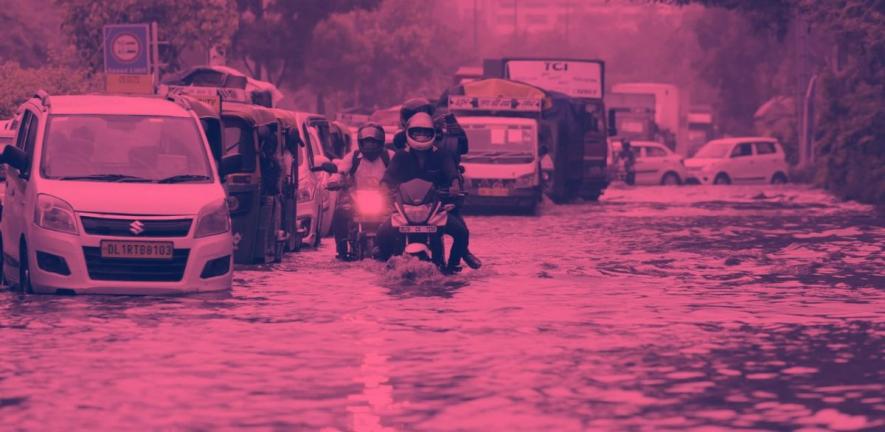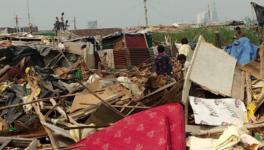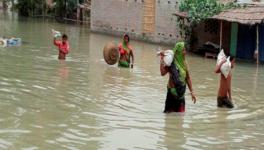Revisiting Shortcomings of Disaster Management Act in Light of Delhi Floods

Image for representational purpose. Credit: The Leaflet
The Disaster Management Act of 2005 has some glaring flaws, and in the midst of an ever-evolving climate crisis, these flaws need to be addressed for the system to function and to effectively mitigate petty problems that may arise.
The 2004 Indian Ocean earthquake and tsunami prompted the government of India to clear the landmark Act which was envisaged with the intent of creating a mechanism to ensure that victims of future natural disasters could get their lives back on track.
The Act provided for the National Disaster Management Authority (NDMA), a body headed by the Prime Minister whose duty was to lay down policies and guidelines to cope with disasters.
Under the NDMA comes the National Disaster Response Force (NDRF), which is supposed to conduct rescue and relief operations in disaster-affected areas.
In the face of the Yamuna flooding the National Capital Region, the Delhi government and the lieutenant general’s office have had a public spar about who is to be blamed for the failure to respond appropriately, with the chief acquisition coming from the government that the NDRF team was not deployed on time.
As the politics of the event unfolds, it is important to note that this is not the first time that the NDRF has failed to respond to a disaster promptly.
The NDRF has also faltered and been called out during the infamous Kerala floods of 2018, and the Kedarnath floods of 2013.
In fact, the NDMA was specifically called out in 2013 by a public interest litigation (PIL) in the Supreme Court for failing to have a disaster management mechanism in calamity-prone states.
Response teams have undoubtedly carried out great work, but as the climate crisis intensifies, it is important that the policy is updated.
Fault lines
When the Act was about to be cleared, many citizens had pointed out that there were some structural flaws in the Bill.
These shortfalls have repeatedly manifested themselves whenever the NDRM has been caught off-guard by a disaster, resulting in delayed responses, blame games between the authorities and so on.
Some of the problems present in the Act are enumerated below.
Lack of role clarity
The Act called for the creation of multiple organisations or bodies at the national, state and district level, but in the process, some of these bodies ended up with overlapping purposes, without a demarcated jurisdiction.
For instance, the NDMA, being the apex body for disaster management, is headed by the Prime Minister, but the NDRF, which effectively carries out rescue operations, falls under the Ministry of Home Affairs.
Moreover, the Parliament has also constituted the National Crisis Management Committee (NCMC) which can guide and direct various government agencies during national crises.
The NCMC is constituted in addition to the NDMA, which itself has state and district units and coordinates with the respective governments.
The District Emergency Operation Centre is another body that has the same functions as that of the district Disaster Management Authority, thus having the perilous potential of creating dual governance in the midst of a crisis.
Red tape
The government has a well-known obsession with bureaucracy as reflected in the copious number of legislations of hierarchy-based organisations which are supposed to work under a unified command.
The Act also suffers from an excessive chain of delegated authorities, and creates a top-down mechanism to deal with natural disasters instead of federalising the problem.
In the process, local players are simply eliminated from the transaction as orders come from the top of the hierarchy.
A dire consequence of this power-division is the delayed response by the government as it remains oblivious to developments on the ground.
This is particularly highlighted with the current Yamuna flooding in the Delhi region, as both the Centre and state authorities are engaging in a public tussle.
Vagueness
Some key terms in the Act are not very well-defined and have repeatedly caused trouble for local communities.
An example of the vagueness in the Act leading to unfavourable outcomes is when the Union and state governments had a public feud while deciding whether the 2018 Kerala floods were to be termed a ‘national disaster’ or not.
However, there is a serious dilemma when calamities are long-drawn, such as droughts, as opposed to calamities which last for a shorter span of time.
The problem was so deeply ingrained in the Bill that the Supreme Court had to intervene and deliver a landmark judgment in Swaraj Abhiyan versus Union of India which laid down the guidelines for dealing with droughts.
However, the problem persists even today.
Devising the right flow
As the climate crisis becomes the most important existential challenge of the century, it is necessary that laws which deal with the problem are regularly updated to accommodate the latest developments, especially in a country like India, where the bureaucracy has disproportionate power.
In this light, immediate changes are needed along the following lines.
Involve local communities
While defending privatisation, Prime Minister Narendra Modi once asked, “Sab kuch babu karega kya?” (Will everything be done by bureaucrats only?).
His statement is absolutely applicable when analysed through the lens of the climate crisis.
The current approach is top-down, with all functional powers to conduct and mitigate disasters remaining heavily dependent on the Union government’s action.
Instead, it would be better if local communities were organised and empowered to take action in the face of a crisis.
It would also be better if non-government groups and experts could be included to take on long-term challenges.
Clarity
Central and authoritarian command is not desirable to deal with problems in a democratic society but there must be some clarity on the delegation of responsibility.
The present system creates a dual set-up which adds chaos to an already volatile situation. Further, in the process of being accommodative, some terms in the Act are very thinly stretched out, allowing the Union government to pull out from responsibility.
Therefore, it is important to elaborate on these terms and add some depth to the term ‘calamity’ and leave less for judicial activists to hammer out.
Institutionalise change
As previously mentioned, the climate crisis is ever-evolving, and expecting one legislation to end all problems is no less than demanding a magic trick.
It would be better if a mechanism were implemented to allow for the constant evolution of bodies and policies to change as newer developments are figured out preferably in a federal local government-led way.
The above mechanism would allow each region to take on catastrophes in their own capacity.
Conclusion
The current disaster management set-up in the country does deliver certain solutions but as problems intensify, the restlessness will also increase.
An already weighed-down system will find it even more difficult to respond to rapidly evolving situations in a timely manner.
The disaster management system of India requires a fresh perspective and fine-tuning. Luckily, the country has the capacity to provide what is needed. But do we have the political will necessary for the task?
Paarth is freelance sports journalist and political commentator.
Get the latest reports & analysis with people's perspective on Protests, movements & deep analytical videos, discussions of the current affairs in your Telegram app. Subscribe to NewsClick's Telegram channel & get Real-Time updates on stories, as they get published on our website.
























